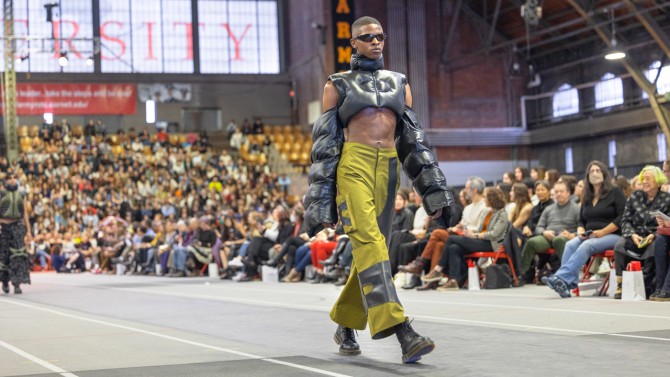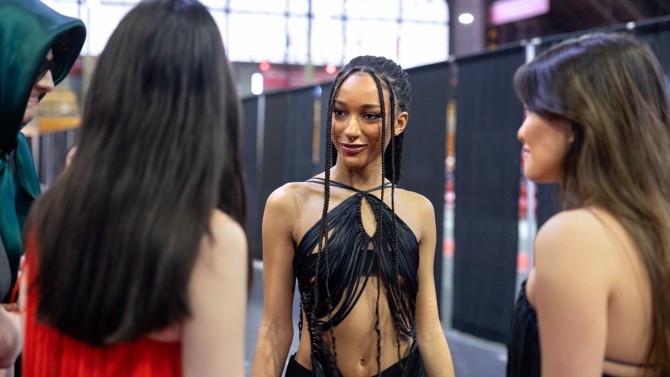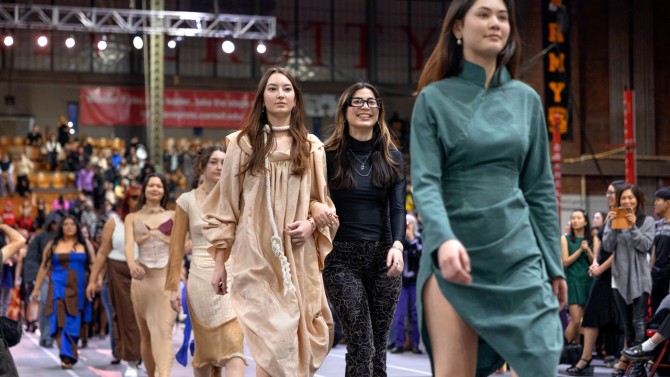The Cornell Fashion Collective’s 39th Annual Spring Runway Show – “In Retrospective Forethought” – examined past and future fashion trends.
Fashion show embodies labor of love for student designers
By Galib Braschler
Metal callouses on the bottom of both shoes. A chest plate constricting the breath. Airy silk and chiffon floating on top of wet-molded leather.
Those elements and more in the fashion collection Antestatis, by designer Drew Brown ’25, represent the physiological response to laboring at work we love, a duality that’s equal parts pain and passion. “There’s an anxiety there … and a true intellectual and physical toll,” he said of his collection. “I sought to represent the heightened reactions, emotions and sentiments of the human body as it is responding to a moment in a person’s life.”
His work illustrates the labor of love at the heart of the Cornell Fashion Collective (CFC) and its annual Spring Runway Show. A student-run production, the 39th edition marked a triumphant return to Barton Hall on March 11 to a sold-out crowd of 3,100 spectators. Since 2019, the show had been held remotely or outdoors due to the COVID-19 pandemic.
“This past weekend’s show was rewarding in so many ways,” said Devin Schneider ’23, CFC president. “Being able to work with my team and provide student designers with an outlet to express and share creativity is something that I’m extremely proud of. And watching the first model step onto the runway on the day of the show – it’s the culmination of all your hard work, and it’s the first time you’re really certain that the event came together.”
Nearly 90 designers brought their creations to life with the help of 150 student models from across Cornell who walked the 300-foot runway. Seven students, all Level 4 designers, each produced a small-scale collection of eight to 12 pieces. Their collections were inspired by concepts as varied as the paradigm of sex and violence throughout classic cinema; the evolution and distillation of 1950s-era fashion; and American Western motifs with European refinement.
The latter collection, titled Gregowicz, was designed by fiber science major Aidan Collins ’23 and dedicated to his grandfather. Collins’ menswear featured unique looks composed of leather, silk and wool, and many of the garments were produced through a series of chemical treatments to impart specific aesthetic finishes.
“I made closer connections during my creative journey and learned from people outside my major. It can be a very collaborative environment when you allow it to be,” Collins said. “In the end, my favorite part was watching my models walk down the runway. They were amazing and kept my spirits up to finish my collection.”
Models worked with their designers to get measured at the end of fall semester, then finalized their looks in the last few weeks prior to the show. Students also participated in “Model Boot Camp” in the final month before the event, where they trained weekly with peer coaches to learn how to walk with poise, confidence and attitude on the runway.
“When I was standing backstage I felt like my heart was going to jump out of my chest,” said Jules Rubin-Grant ’25, a sophomore in the College of Arts and Sciences, who modeled for the first time in this year’s show. “However, while I was walking I felt surprisingly at peace, and when returned backstage I had the biggest grin; I was proud of myself for walking, getting out of my comfort zone and I was glad that it was over.”
This year’s CFC show was reimagined to engage more fully with the audience. “Barton Hall is massive, so every placement and detail is important,” Collins said.
Models walked the length, then across the top of the “T”-shaped runway to give the crowd in the bleachers a longer look, allowing models to showcase their personalities and perfected runway poses.
A giant screen behind the runway displayed videos from the designers that matched their collections. Organizers said the screen was meant to simulate the experience of spectators “sitting inside” the creative process going on inside the mind of a designer, adding another new dimension to the annual show.
“A lot of people do not realize how much work the executive board and the rest of the organization puts into executing the runway show, but behind the scenes and black draperies, it is quite impressive,” Collins said. “I admire the creativity and hard work of everyone in the organization. My friends and I already have some ideas for next year’s show, and I think that just shows how much the organization is trying to improve and make it more engaging with each passing year.”
Galib Braschler is a communications specialist in the College of Human Ecology. Communications assistant Marisa LaFalce provided additional reporting.
Media Contact
Abby Kozlowski
Get Cornell news delivered right to your inbox.
Subscribe



